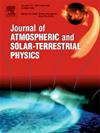Characterizing long-term cosmic ray time series with geometric network curvature metrics
IF 1.8
4区 地球科学
Q3 GEOCHEMISTRY & GEOPHYSICS
Journal of Atmospheric and Solar-Terrestrial Physics
Pub Date : 2025-01-10
DOI:10.1016/j.jastp.2025.106418
引用次数: 0
Abstract
This study investigates the relationship between geometry and nonlinear dynamics in time series of cosmic ray counts recorded at neutron monitors at ground stations. Using advanced geometric and topological analysis techniques, we construct complex networks from the time series and calculate curvature measures such as Ollivier-Ricci curvature, Forman-Ricci curvature, and Ricci flow for each series. The analysis reveals significant correlations between these curvature metrics and key parameters such as geomagnetic cutoff rigidity and detector latitude. In particular, Forman-Ricci curvature exhibits a robust negative correlation with cutoff rigidity (Pearson , Spearman , -value ), while Ricci flow also shows a strong and highly significant inverse relationship with cutoff rigidity (Pearson , Spearman , -value ). These results suggest that the geometrical structure of the networks, influenced by geomagnetic conditions, plays a crucial role in the variability, complexity, and fractality of cosmic ray time series. Furthermore, the study underscores the importance of considering network topology and curvature metrics in the analysis of cosmic ray data, offering new perspectives for understanding space weather phenomena and improving predictive models. This integrative approach not only advances our knowledge of cosmic ray dynamics, but also has important implications for mitigating risks associated with space weather conditions on Earth.
用几何网络曲率度量描述长期宇宙射线时间序列
本文研究了地面站中子监测仪记录的宇宙射线计数时间序列中几何结构与非线性动力学之间的关系。利用先进的几何和拓扑分析技术,我们从时间序列中构建复杂网络,并计算每个序列的曲率度量,如奥利维-里奇曲率、福尔曼-里奇曲率和里奇流。分析表明,这些曲率指标与地磁截止刚度和探测器纬度等关键参数之间存在显著的相关性。特别是,Forman-Ricci曲率与截止刚度呈显著负相关(Pearson r= - 0.85, Spearman ρ= - 0.86, p值<;10−5),而Ricci流也与截止刚度呈显著负相关(Pearson r= - 0.92, Spearman ρ= - 0.89, p值<;10−7)。这些结果表明,受地磁条件影响的网络几何结构对宇宙射线时间序列的变异性、复杂性和分形性起着至关重要的作用。此外,该研究强调了在宇宙射线数据分析中考虑网络拓扑和曲率度量的重要性,为理解空间天气现象和改进预测模型提供了新的视角。这种综合方法不仅提高了我们对宇宙射线动力学的认识,而且对减轻与地球上空间天气条件相关的风险具有重要意义。
本文章由计算机程序翻译,如有差异,请以英文原文为准。
求助全文
约1分钟内获得全文
求助全文
来源期刊

Journal of Atmospheric and Solar-Terrestrial Physics
地学-地球化学与地球物理
CiteScore
4.10
自引率
5.30%
发文量
95
审稿时长
6 months
期刊介绍:
The Journal of Atmospheric and Solar-Terrestrial Physics (JASTP) is an international journal concerned with the inter-disciplinary science of the Earth''s atmospheric and space environment, especially the highly varied and highly variable physical phenomena that occur in this natural laboratory and the processes that couple them.
The journal covers the physical processes operating in the troposphere, stratosphere, mesosphere, thermosphere, ionosphere, magnetosphere, the Sun, interplanetary medium, and heliosphere. Phenomena occurring in other "spheres", solar influences on climate, and supporting laboratory measurements are also considered. The journal deals especially with the coupling between the different regions.
Solar flares, coronal mass ejections, and other energetic events on the Sun create interesting and important perturbations in the near-Earth space environment. The physics of such "space weather" is central to the Journal of Atmospheric and Solar-Terrestrial Physics and the journal welcomes papers that lead in the direction of a predictive understanding of the coupled system. Regarding the upper atmosphere, the subjects of aeronomy, geomagnetism and geoelectricity, auroral phenomena, radio wave propagation, and plasma instabilities, are examples within the broad field of solar-terrestrial physics which emphasise the energy exchange between the solar wind, the magnetospheric and ionospheric plasmas, and the neutral gas. In the lower atmosphere, topics covered range from mesoscale to global scale dynamics, to atmospheric electricity, lightning and its effects, and to anthropogenic changes.
 求助内容:
求助内容: 应助结果提醒方式:
应助结果提醒方式:


